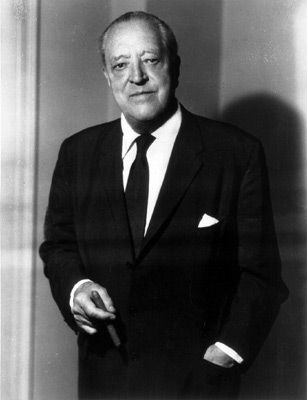
Ludwig Mies van der Rohe
Ludwig Mies van der Rohe (/miːs ... roʊ/ MEESS-...-ROH; German: [ˈluːtvɪç ˈmiːs fan deːɐ̯ ˈʁoːə]; born Maria Ludwig Michael Mies; March 27, 1886 – August 17, 1969) was a German-American architect, academic, and interior designer.[1] He was commonly referred to as Mies, his surname. He is regarded as one of the pioneers of modern architecture.
Not to be confused with Ludwig von Mises.
Ludwig Mies van der Rohe
August 17, 1969 (aged 83)
- Germany (1886–1944)
- United States (1944–1969)
Architect
4
- Pour le Mérite (1959)
- Royal Gold Medal (1959)
- AIA Gold Medal (1960)
- Presidential Medal of Freedom (1963)
In the 1930s, Mies was the last director of the Bauhaus, a ground-breaking school of modernist art, design and architecture.[2] After Nazism's rise to power, with its strong opposition to modernism, Mies emigrated to the United States. He accepted the position to head the architecture school at what is today the Illinois Institute of Technology (IIT).
Mies sought to establish his own particular architectural style that could represent modern times. His buildings made use of modern materials such as industrial steel and plate glass to define interior spaces. He is often associated with his fondness for the aphorisms "less is more" and "God is in the details".
Early career[edit]
Mies was born March 27, 1886, in Aachen, Germany.[3] He worked in his father's stone carving shop[3] and at several local design firms before he moved to Berlin, where he joined the office of interior designer Bruno Paul.[4] He began his architectural career as an apprentice at the studio of Peter Behrens from 1908 to 1912,[5] where he was exposed to the current design theories and to progressive German culture. He worked alongside Le Corbusier and Walter Gropius, who was later also involved in the development of the Bauhaus. Mies served as construction manager of the Embassy of the German Empire in Saint Petersburg under Behrens.[6]
Ludwig Mies renamed himself as part of his transformation from a tradesman's son to an architect working with Berlin's cultural elite, adding "van der" and his mother's maiden name "Rohe"[7][8] and using the Dutch "van der", because the German form "von" was a nobiliary particle legally restricted to those of German nobility lineage.[9] He began his independent professional career designing upper-class homes.[10]
Personal life[edit]
In 1913 Mies married Adele Auguste (Ada) Bruhn (1885–1951), the daughter of a wealthy industrialist.[11] The couple separated in 1918, after having three daughters: Dorothea (1914–2008), an actress and dancer who was known as Georgia, Marianne (1915–2003), and Waltraut (1917–1959),[12] who was a research scholar and curator at the Art Institute of Chicago. During his military service in 1917, Mies fathered a son out of wedlock.[13]
In 1925, Mies began a relationship with designer Lilly Reich that ended when he moved to the United States; from 1940 until his death, artist Lora Marx (1900–1989) was his primary companion. Mies carried on a romantic relationship with sculptor and art collector Mary Callery for whom he designed an artist's studio in Huntington, Long Island, New York.[14] He had a brief romantic relationship with Nelly van Doesburg. After having met in Europe many years prior, they met again in New York in 1947 during a dinner with Josep Lluís Sert where he promised her he would help organize an exhibition in Chicago featuring the work of her late husband Theo van Doesburg. This exhibition took place from October 15 until November 8, 1947, with their romance officially ending not much later. Nevertheless they remained on good terms, spending Easter together in 1948 at a modern farmhouse renovated by Mies on Long Island, as well as meeting several more times that year.[15]
Archives[edit]
The Ludwig Mies van der Rohe Archive, an administratively independent section of the Museum of Modern Art's department of architecture and design, was established in 1968 by the museum's trustees. It was founded in response to the architect's desire to bequeath his entire work to the museum. The archive consists of about nineteen thousand drawings and prints, one thousand of which are by the designer and architect Lilly Reich (1885–1947), Mies van der Rohe's close collaborator from 1927 to 1937; of written documents (primarily, the business correspondence) covering nearly the entire career of the architect; of photographs of buildings, models, and furniture; and of audiotapes, books, and periodicals.
Archival materials are also held by the Ryerson & Burnham Libraries at the Art Institute of Chicago. The Ludwig Mies van der Rohe Collection, 1929–1969 (bulk 1948–1960) includes correspondence, articles, and materials related to his association with the Illinois Institute of Technology. The Ludwig Mies van der Rohe Metropolitan Structures Collection, 1961–1969, includes scrapbooks and photographs documenting Chicago projects.
Other archives are held at the University of Illinois at Chicago (personal book collection), the Canadian Centre for Architecture (drawings and photos) in Montreal, the Newberry Library in Chicago (personal correspondence), and at the Library of Congress in Washington D.C. (professional correspondence).